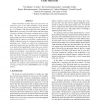Free Online Productivity Tools
i2Speak
i2Symbol
i2OCR
iTex2Img
iWeb2Print
iWeb2Shot
i2Type
iPdf2Split
iPdf2Merge
i2Bopomofo
i2Arabic
i2Style
i2Image
i2PDF
iLatex2Rtf
Sci2ools
HPCA
2009
IEEE
2009
IEEE
Optimizing communication and capacity in a 3D stacked reconfigurable cache hierarchy
Cache hierarchies in future many-core processors are expected to grow in size and contribute a large fraction of overall processor power and performance. In this paper, we postulate a 3D chip design that stacks SRAM and DRAM upon processing cores and employs OS-based page coloring to minimize horizontal communication of cache data. We then propose a heterogeneous reconfigurable cache design that takes advantage of the high density of DRAM and the superior power/delay characteristics of SRAM to efficiently meet the working set demands of each individual core. Finally, we analyze the communication patterns for such a processor and show that a tree topology is an ideal fit that significantly reduces the power and latency requirements of the on-chip network. The above proposals are synergistic: each proposal is made more compelling because of its combination with the other innovations described in this paper. The proposed reconfigurable cache model improves performance by up to 19% along ...
Cache Hierarchies | Computer Architecture | Heterogeneous Reconfigurable Cache | HPCA 2009 | Reconfigurable Cache Model |
| Added | 25 Nov 2009 |
| Updated | 25 Nov 2009 |
| Type | Conference |
| Year | 2009 |
| Where | HPCA |
| Authors | Niti Madan, Li Zhao, Naveen Muralimanohar, Aniruddha Udipi, Rajeev Balasubramonian, Ravishankar Iyer, Srihari Makineni, Donald Newell |
Comments (0)

